Unless you live in Hawaii, if you live in the United States, you probably have a coyote living nearby. They sneak around Central Park, abound in the Grand Canyon, and have alarmed sunbathers on Palm Beach.
Coyotes dine on dog food left near your back door, snack on the cat you forgot to bring in, and patrol the sleepy suburban streets you live on, more often than the local cop.
Whether you live in the city or the sticks, you’ve likely never seen one. Worse, you are blind to them. More importantly, you have no idea how much damage this increasing number of predators is doing today—and will do in the future.
Don’t blame yourself; Big Cartoon duped you with Fake News while you scarfed down your Sugar Flakes.
Sorry, but the slowest wiley coyote is twice as fast as a road runner.
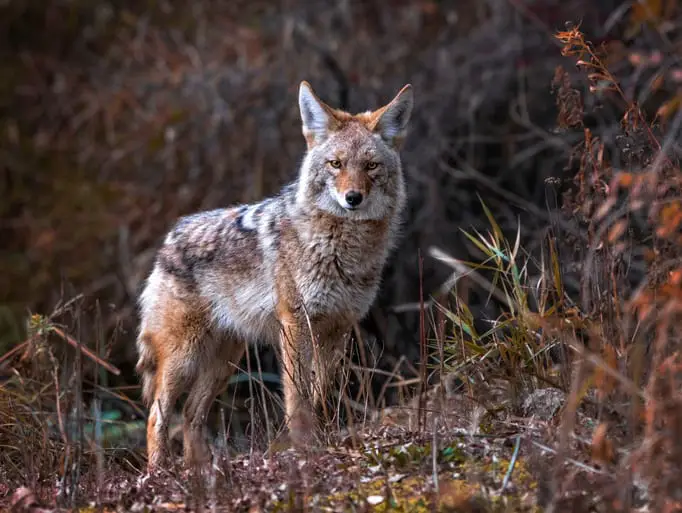
What is a coyote?
A coyote is an undomesticated canine native to North America. Its slender muzzle, bushy, low-hanging tail, and pointed ears resemble a camouflaged German Shepard. Intelligent, highly communicative, and designed to adapt and thrive in almost any environment, a coyote is also surplus-killing predator.
The scientific name for the species” Canis latrans” means” barking dog.” There are 19 known subspecies of the coyote. The Canis latrans var (more familiarly known as the Eastern Coyote) is the largest of the subspecies.
Coyote fur colors are varied, often geographically, but predominantly light gray or brownish yellow patches mixed around its body with black and white. A coyote’s eyes are yellow (most domestic dogs are brown). A coyote’s tail often has a black tip at the end and is always carried low when moving at any speed (unlike domesticated dogs).
Coyote tracks are often straight lines (compared to a dog’s meandering path) and are narrower and more elongated than a dog’s. Related: Learn how to read coyote tracks and scat.
Western coyotes have an average weight between 20-25 pounds, while the Eastern Coyote averages between 25-45 pounds. The largest coyote ever recorded topped the scales at 75lbs.
Where do coyotes live?
As long as there are no wolves, coyotes can successfully thrive everywhere in the United States. Grasslands, shrublands, forests, mountains, and even deserts have established coyote populations. As long as there is an abundant food source, coyotes can adapt to almost every situation.
Premium habitat, however, will contain plenty of rabbits. Despite the occasional fawn, coyotes thrive on the rabbit. Rabbits are herbivores. The plants, leaves, weeds, and grasses they live on are found in open grassy areas, old fields, and clearings. Brian Rush of Rushcustomcallers.com calls this area where rabbits find food, water, and shelter “rabbit-tat.” Rabbit-tat is also the perfect home for field mice, voles, insects, and birds—all of which feature on a coyote’s menu.
Croplands and other areas with fruits, vegetables, and vegetative matter can also support a healthy coyote population. As we will see in the coyote diet section, a coyote’s belly is usually full of fruit and vegetables rather than meats.
Coyotes prefer to hunt the edges between two zones in rural areas, like woodlands and open fields. These areas provide cover for the coyotes, concealing them from prey and predators. Coyotes will reside in parks, small woodlots, and quiet, open spaces like golf courses in urban areas.
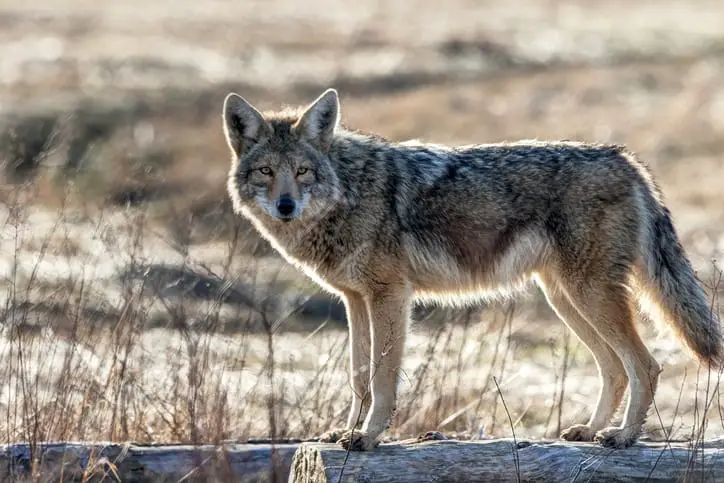
Where do coyotes sleep?
One of the myths about coyotes is that they are primarily crepuscular (active during twilight) or even strictly diurnal (sleeping during the night and active during the day). In my article “What’s the best time of day to hunt a coyote,” I point out the numerous studies showing coyotes are much more active between sunset and sunrise than at any other time.
Another long-held and shared belief is that coyotes live and sleep in dens. Coyotes will only use a den to sleep in during the pup rearing and raising season. And even then, the Alpha male will sleep outside the shelter to protect his mate and offspring.
Outside of pup raising season, coyotes do not spend any time staying or sleeping in dens.
When coyotes are not using dens, they sleep and rest in elevated bedding sites that provide them with cover and, simultaneously, allow them to observe their surroundings. When coyotes use dens, only the mother and pups will sleep in them.
As well as providing elevation and cover, coyote bedding areas are typically isolated, bushy, and harsh. A human or animal would make a lot of noise entering such dense and inaccessible bedding—easily enough noise to wake up and alert a napping coyote.
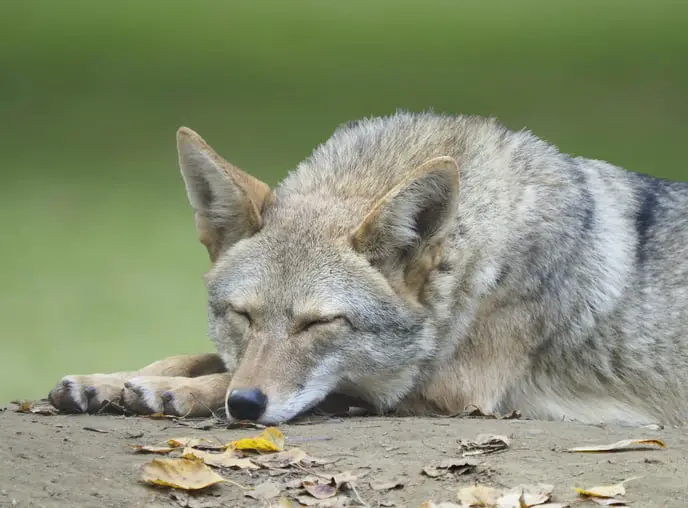
Where do coyotes sleep in bad weather?
In inclement weather, coyotes will sleep in areas that protect from heavy rains, high winds, and snow. In a strong gale, a coyote will rest behind anything that blocks the wind. Thick tree lines and low areas such as washes and drainage bottoms are good examples of terrain that will wall off the worst effects of even the harshest wind.
During even the worst rain storms, a coyote changes little in how it selects a bedding location. As long as the terrain drains enough to keep the ground under the coyote dry, it will simply ignore even a heavy downpour.
A coyote might nap under an overhang, evergreen bough, or sleep in the snow during a snow storm. As noted above, a coyote will seek cover if strong winds and freezing temps accompany the snow.
Related: Hunting predators in bad weather.
What do coyotes eat?
A coyote’s diet will depend on the time of the year and where it lives.
In the winter, coyotes survive on rabbits and deer (often carrion). Studies of the Eastern coyote have found snowshoe hare in just over 50% of the bellies of coyotes taken. Deer, on the other hand, were found in 31%. Voles make up nearly 2/3 of a coyote’s diet if there is little snow on the ground.
In the spring and summer, along with mice, deer, and rabbits, coyotes will eat a host of insects (especially grasshoppers) and plants.
During the fall, coyotes will happily consume their fill of fruits like plums, berries, and watermelon.
Related: The entire coyote’s diet.
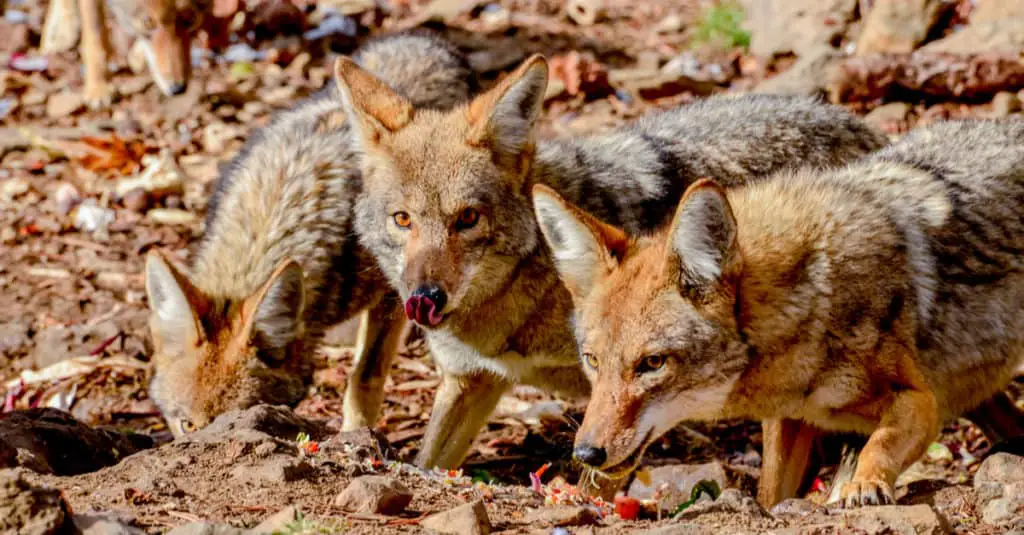
Coyote mating information.
After the most recent litter of pups has dispersed, the next stage of life for a coyote is mating season. Mated pairs with females less than ten years old and newly bonded couples with females at least two years old are most likely to produce a litter. Females in their first year or over ten years of age are less likely to become pregnant.
Coyote mating occurs once per year. Coyote mating season begins mid-January and peaks in late February to early March. The resulting pups are born between mid-March to mid-May. Female coyotes are monoestrous animals with only one heat during their breeding season.
Coyote mating season starts with the search for a suitable mate for unattached males and females. Coming on the heels of dispersal season (when first-year pups are forced out of their parent’s territory), this leads to increased travel, more frequent vocalizations, and sightings by humans.
Only the dominant male and female will breed among established family units if any mature offspring have yet to disperse. The remaining offspring will assist in raising and defending the next litter.
How do coyotes find a mate?
Unmated coyotes face a harsh first winter. Forced from their birth homes, they must seek out an unclaimed territory of their own before tryin to locate a potential mate. If they trespass on another coyote’s territory, they may be attacked, forced to submit, and driven off.
Many new hazards also await these traveling coyotes. Unfamiliar with the new areas they enter, locating food and water is difficult. New dangers like vehicle traffic, urban environments, traps, and hunters abound.
If they successfully navigate their way through all these perils, they must still find an available, willing, and suited mate.
The selection of a mate begins with a female nearing estrus. It ends when she decides which male is the best.
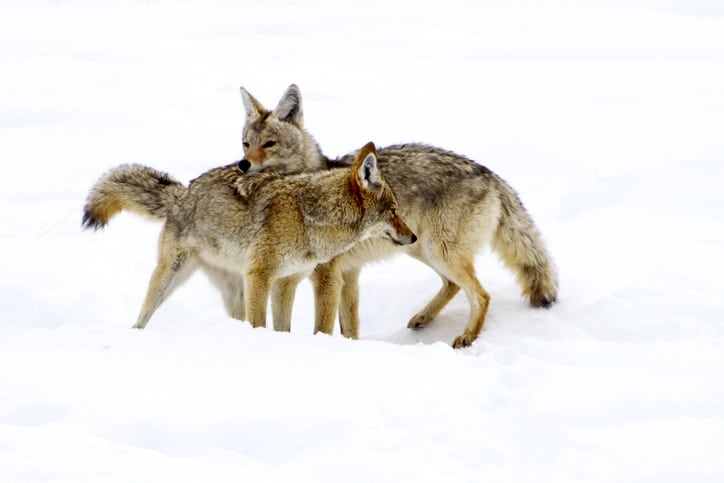
How do coyotes choose a mate?
Coyotes mate for life. The mate selection process is meant preserve the genetic line, ensure the two are suited for a lifetime pairing, and will provide a strong parental unit for future litters.
Coyotes choose their mates by first listening and responding to each other’s calls. A male enters a female’s territory and follows her as she hunts. Unless rebuffed, he will increase his interactions with her—laying close by, playing, grooming, guarding, and eventually copulating when she is ready.
Interestingly, whether or not the female becomes pregnant, the pair will still seek out a location for a den. Some researchers believe female coyotes who will not bear offspring still display maternal behaviors and activities and physical signs like nesting and swollen bellies.
Life as a coyote parent.
Coyote parents have about one year to get their pups born, reared, and released alone into the world. While they do a remarkable job caring for their young, only about 30% survive their first year in the wild.
Contrary to popular belief, the number of coyote pups born in a litter is not affected by food availability or death rate (such as from hunting or trapping). Only the mother’s fertility determines the number of pups she gives birth to. Coyotes have no news networks, information sources, or magical abilities to sense increases or decreases in overall coyote population numbers.
Preparing a coyote den.
After mating, the pair must find a place to bear and raise the future litter. The coyote gestation period (60-63 days) gives them roughly two months to finish the job.
It is the female coyote’s job to do all the digging and alterations. She may dig an entirely new hole, expand an abandoned badger, skunk, or other animal’s den, or use a rock outcropping or hollowed-out tree. The shelter will be located near a water source, have good drainage, and sport a southern-facing opening.
While the female prepares the den, the male will guard her and bring her food. Again, whether genuinely pregnant or not, the female will be the male for regurgitated food, and he will provide it.
Other than when she is hungry, the female will avoid contact with the male. In most cases, she will not exit the den until about ten days after the pups are born. At this time, she will start taking short trips away for water and food for herself.
Most coyotes will dig at least two dens to provide a safe backup in case of detection.
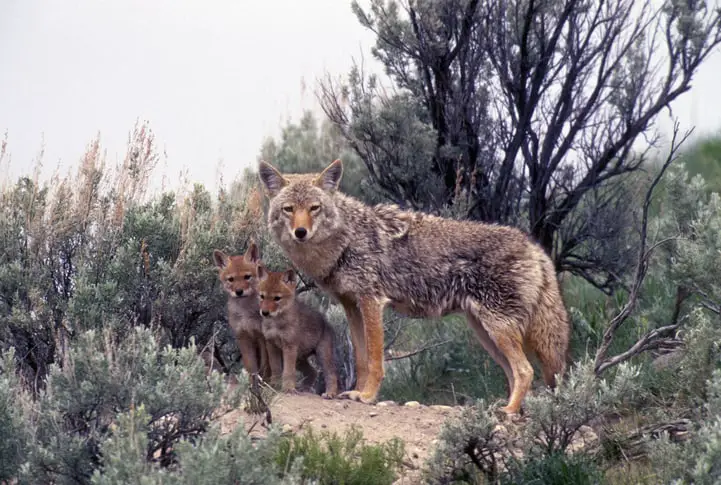
After the coyote pups are born.
Newly born coyote pups are blind and helpless but constantly protected and attended to by their parents.
Within ten days, the pups’ eyes are open, and they begin exploring their home. For the first six weeks or so, mom provides them with milk. After weaning, she will regurgitate food for them and then introduce a variety of dead rodents for them to consume. Before they exit their home, live rodents will be provided to help the pups learn how to kill their own food.
Life as a new coyote pup.
Within 35 days of birth, a coyote pup starts exploring the world outside its den. Everything will be new and different for the next few months, except for its parents’ constant presence and oversight.
The pup is moved to a new location shortly after being weaned and able to kill and eat its own small prey. After providing the perfect sanctuary, the den is forever abandoned, never to be returned to by this pup.
The coyote pup will never again live below ground unless it is female. To ready it for its new lifestyle, mom and dad will take it to areas like fields with tall grasses and the edges between tree lots and open plains. Here the pups will accompany their parents on short hunts. For a while, they are always remaining in visual touch. With time, they will start temporarily leaving their parent’s side and testing their hunting skills independently.
Once the pup has reached about nine months old, it is ready to survive on its own. This is just in time for mom and dad to start work on ready things for the next litter. The parent’s next step? Kicking the adult pups out of their territory.
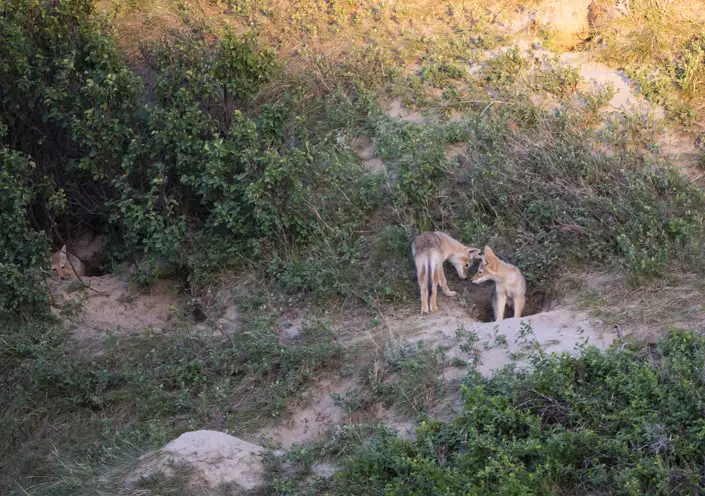
Coyote pup dispersal season.
In most of the United States, adult coyote pups are forced out of their family units by September. Far from helpless and trained to hunt and kill by their parents, these young adults will eagerly begin the process of finding territory and mates.
While some females may remain behind, all males are forced to leave to prevent inbreeding. The remaining females will spend the next year acting as helpers to raise the next litter.
Coyote pup dispersal season is noted for one thing in the United States, the sudden appearance of numerous roaming coyotes—and dozens of local news stories warning the public of the danger.
Much of the information, and many of the human-coyote interactions, are filled with misconceptions and, often, mere myths.
Facts and myths about coyotes.
A coyote is an animal in one of two states, protecting its territory or hunting for food. It is not malicious. It does not possess superpowers or magical capabilities. While it may be hazardous to humans under certain conditions, a coyote survives by actively avoiding contact with humans.
The real number of coyotes you hear howling at night.
Long before they have ever seen a coyote, many people hear them howling or barking. Safely sitting around a campfire or drinking a beer on their back deck, the sudden yipping, yelping, howling, and barking shocks these folks.
Most people hearing coyotes howl significantly overestimate the number of coyotes involved. They believe there must be 5-10 wild dogs nearby, gathering in the darkness and preparing to attack.
In reality, there are usually no more than two or three, and they are simply telling the rest of their family where they are located.
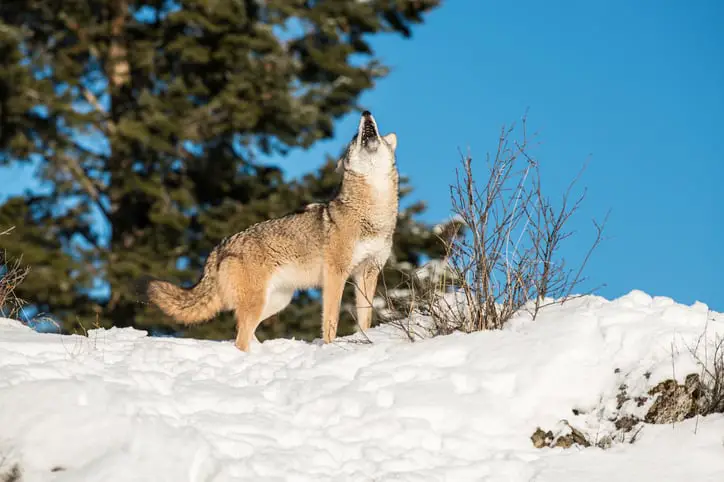
Beau Geste, French for “Fooled ya!”
There are two reasons why just a pair of coyotes howling can sound like a ”pack.”
First, each dog produces several different sounds. As these sounds travel through the air, the environment (trees, bushes, weather) distorts the vocalizations. This creates an auditory allusion the human ear interprets as separate and distinct sounds.
Second, the Beau Geste effect achieves the same result on other non-family coyotes. Potential trespassers (like transient coyotes or other family units) also significantly overestimate the size of the group vocalizing. Sounding like your group is huge in numbers is the safest way to avoid conflict.
Understanding coyote barks and howls.
Coyote communication is complicated (with the ability to make dozens of sounds) but there are only a few facts you need to understand to interpret most of what you will hear daily.
Most coyote vocalizations consist of two basic vocalizations; howls and barks.
Howls communicate information (who is calling) and location. Howls carry a long way and are undistorted by distance. Humans can hear a howl made by a coyote almost a mile away, but other coyotes can listen to it nearly three miles away.
Barks are higher frequency calls, degrade rapidly, and communicate who is calling and exactly how far away they are from the hearer. Barks are used to warn of trouble or danger. A coyote hearing a bark knows a family member needs help and precisely which direction they are in and the travel distance to reach them.
As a human, you can safely enjoy the howling. Only the barks, if loud, could apply to you. A loud barking coyote is defending something from which it cannot move away. Back off, and that coyote will leave you alone.
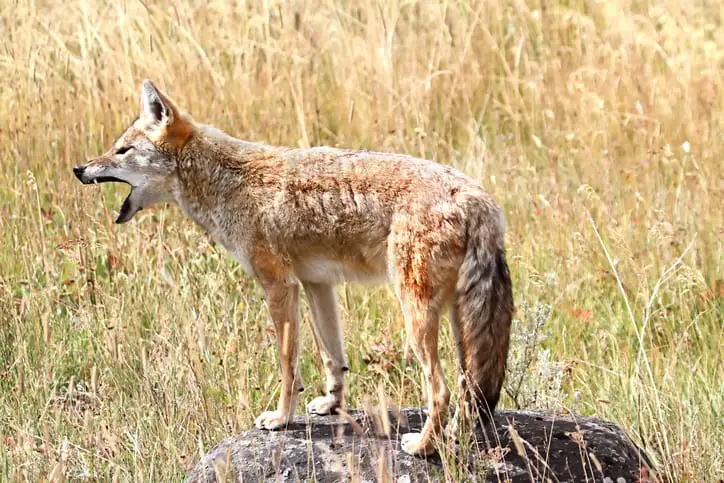
Coyotes can be a serous problem, but they don’t hunt humans.
Coyotes definitely cause a lot of problems for humanity.
You may be in a war with coyotes if you own a small homestead with a few chickens or ducks. Coyotes can wreck your livestock and your profits if you are a rancher in the middle of calving season.
Deer hunters hate finding the remains of fawns left behind by these voracious predators. They rue the loss of potential trophy animals that might have been harvested and eaten a few years into the future.
Many pet owners, both in the city and rural areas, never see their cats or small dogs again, nor discover the true fate of their furry friends.
Nearly unchecked, except for an ever-decreasing number of predator hunters and trappers, the coyote population is swelling today. And every year, coyotes adapt and expand into new territories. Once settled, they always manage to thrive, despite the conditions.
As the media and the crazies clamor to end the sport of trapping and coyote hunting, human-coyote interactions will increase in number and severity. Despite all its efforts to avoid humankind, the poor coyote will be blamed for every injury or scare, absolute or imagined.
It can only end in the one thing no true coyote hunter or trapper wants: A united effort to kill off all these fantastic and greatly respected creatures.
Related: Using predator hunters to protect farms and ranches.
Pets and coyotes.
Except for small dogs and cats left unattended and outside, coyotes don’t present a hazard to your pets.
Coyotes still believe there is such a thing as a free meal. Coyotes stalk and take prey that is quickly overpowered and readily available. They want to surprise their next meal. They don’t want a fight and can’t trick their prey or conjure up and carry out tricky battle plans.
Let’s take Fido, a medium-sized dog, and look at a few examples of what is really happening when he encounters a coyote.
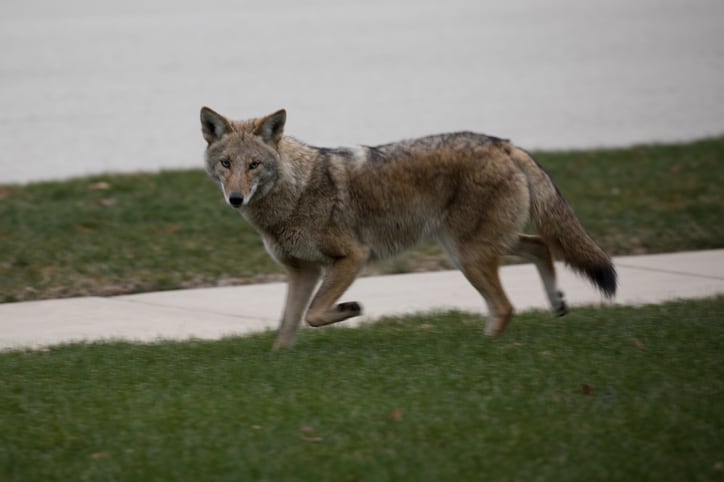
Coyote escorting and play behavior.
If Fido is walking with you and a coyote appears and begins following the two of you, what’s going on? Is the coyote planning on attacking you or Fido? Is it cleverly awaiting additional coyotes before beginning a combined assault?
Answer: It is escorting the two of you away from something, probably a den or some pups out exploring the world. The minute you are far enough away for the coyote to feel the threat has ended, the coyote will disappear. If Fido is on a leash, nothing will happen. If Fido isn’t on a leash, get him under control and at your side until you have moved off.
What if Fido is out in his huge backyard, and there is no fence to keep him in. You look out your kitchen window and see him playing a back-and-forth game of chase with a single coyote. Are a dozen other coyotes waiting to pounce on him the moment he enters the wood-line? Is Fido being lured to his death?
Answer: This may also be an attempt to escort Fido away, or divert his attention from, something the coyote is protecting. And, funny enough, coyotes are dogs, and even coyotes are not immune from the urge to play with or be curious about another dog.
To keep Fido from getting into a spot where the coyote must use force, bring him inside until the coyote is gone. The coyote, if it did consider Fido a threat, would quickly move what it was protecting away from him.
There is no such thing as a coyote pack.
Coyotes live as either solitary animals or members of a family unit. They don’t form groups of unrelated (genetically different) members.
The solitary coyote is nearly always a transient (a traveling coyote looking for a home), a family member out hunting alone, or a dog that has lost its mate.
Coyote family units comprise an alpha male and an alpha female (father and mother), plus several offspring. The offspring in the family will mainly consist of the most recent litter, with one or two older female helpmates from a previous litter.
Since they are, in fact, not packs, multiple members rarely engage in coordinated attacks on larger animals (like deer). When such attacks occur, they are the result of luck (two or more coyotes were traveling together when the prey was spotted), or the sounds of an individual involved in the struggle were heard, and other family members came to assist.
That coyotes do frequently hunt and travel alone is one of the key differences between them and wolves. While a wolf may sometimes hunt by itself, their social structure and the prey they pursue normally mandates the larger numbers of a pack.
Accurate coyote information benefits everyone.
Coyotes, adequately controlled, have a valuable place in our ecosystem. However, as intelligent and adaptive as they are, it would be a mistake to let them run unmolested by their only natural predator (outside of wolves), humanity.
If trappers and coyote hunters are not allowed to pursue and take coyotes, the financial destruction they will wreak will come years before the urge to eliminate them. Neither outcome is desired nor warranted.
If you like coyotes, enjoy them and their nighttime songs. Just remember, like any animal, they are here to serve us and must remain a benefit.

